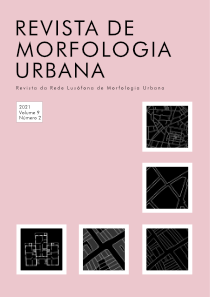Abstract
The phenomenon of 'verticalization' in Brazilian cities has become more intense in the past decades, as a result of market forces and expectations on living styles that manifest themselves through the increasing construction and supply of apartment buildings; or by adapting existing ones. This article investigates the phenomenon of verticalization in the neighborhood of Manaíra, João Pessoa, Paraíba, Brazil, through data mining and visualization techniques in order to classify apartments for sale using the K-means clustering method. First, the research investigated the degree to which the offers of apartments mirrored the particular characteristics of verticalization in Manaíra, which are strongly constrained by legislation and the relative location of buildings within the neighborhood. Then, it looked at some characteristics of the buildings in the neighborhood and the presence of 'fortification' strategies, i.e. walls, security equipment, etc. The results contributed to show the potential that data mining techniques have in the field of architecture and urbanism, producing visualizations that throw light on the phenomenon of verticalization in Manaíra from limited data, explaining the influence of local constraints and, in parallel, the widespread adoption of 'fortification' strategies.
References
Anaconda Software Distribution. [Computer software]. (2019) https://anaconda.com.
Abraham, J. M., Goetzmann, W. N., & Wachter, S. M. (1994). Homogeneous groupings of metropolitan housing markets. Journal of Housing Economics, 3(3), 186-206.
Alonso de Andrade, P. (2017). Verticalização em João Pessoa. Produção do espaço e transformações urbanas. Arquitextos, São Paulo, ano 17, n. 204.02, Vitruvius, maio 2017. https://vitruvius.com.br/revistas/read/arquitextos/17.204/6555.
Alonso de Andrade, P., Berghauser Pont, M., & Amorim, L. (2018). Development of a measure of permeability between private and public space. Urban Science, 2(3), 87.
Anderson, C. (2008). The end of theory: The data deluge makes the scientific method obsolete. Wired magazine, 16(7), 16-07.
Demšar, J., Curk, T., Erjavec, A., Gorup, ?., Ho?evar, T., Milutinovi?, M., Možina, M., Polajnar, M., Toplak, M., Stari?, A. and Štajdohar, M., (2013). Orange: data mining toolbox in Python. The Journal of machine Learning research, 14(1), pp.2349-2353.
Gonzalez, M. C., Hidalgo, C. A., & Barabasi, A. L. (2008). Understanding individual human mobility patterns. Nature, 453(7196), 779-782.
Boeing, G. (2021). Spatial information and the legibility of urban form: Big data in urban morphology. International Journal of Information Management, 56, 102013.
Caldeira, T. P. R. (2000). Cidade de muros: crime, segregação e cidadania em São Paulo. Editora 34.
Fahad, A., Alshatri, N., Tari, Z., Alamri, A., Khalil, I., Zomaya, A. Y., ... & Bouras, A. (2014). A survey of clustering algorithms for big data: Taxonomy and empirical analysis. IEEE transactions on emerging topics in computing, 2(3), 267-279.
Figueiredo, L. (2012). Desurbanismo: um manual rápido de destruição de cidades. In: Netto, V. M & Aguiar, D. Urbanidades. Rio de Janeiro: Folio Digital: Letra e Imagem, 209-234.
Gil, J., Beirão, J. N., Montenegro, N., & Duarte, J. P. (2012). On the discovery of urban typologies: data mining the many dimensions of urban form. Urban morphology, 16(1), 27.
Heyman, A., Law, S., & Berghauser Pont, M. (2019). How is Location Measured in Housing Valuation? A Systematic Review of Accessibility Specifications in Hedonic Price Models. Urban Science, 3(1), 3.
Hillier, B. (1996). Cities as movement economies. Urban design international, 1(1), 41-60.
Jain, A. K. (2010). Data clustering: 50 years beyond K-means. Pattern recognition letters, 31(8), 651-666.
Kluyver, T., Ragan-Kelley, B., Pérez, F., Granger, B.E., Bussonnier, M., Frederic, J., Kelley, K., Hamrick, J.B., Grout, J., Corlay, S. & Ivanov, P., (2016). Jupyter Notebooks - a publishing format for reproducible computational workflows (Vol. 2016, pp. 87-90).
MacQueen, J. (1967, June). Some methods for classification and analysis of multivariate observations. In Proceedings of the fifth Berkeley symposium on mathematical statistics and probability (Vol. 1, No. 14, pp. 281-297).
Marcus, L., Heyman, A., Hellervik, A., & Stavroulaki, G. (2019, July). Empirical support for a theory of Spatial Capital: Housing prices in Oslo and land values in Gothenburg. In 12th Space Syntax Symposium (Vol. 12). 12th International Space Syntax Symposium (12SSS).
Netto, V. M., Saboya, R. T. D., Vargas, J. C., & Carvalho, T. (2017). Efeitos da arquitetura: os impactos da urbanização contemporânea no Brasil. Brasília: Frbh.
Nóbrega, F. D. de (2011). O processo de verticalização e a (re) produção da cidade: um estudo do bairro de Manaíra em João Pessoa, Paraíba (Dissertação de Mestrado). Programa de Pós-Graduação em Arquitetura e Urbanismo, Universidade Federal da Paraíba, João Pessoa.
QGIS Development Team. (2019). QGIS Geographic Information System [Computer Software]. Open Source Geospatial Foundation Project. http://qgis.osgeo.org
Rousseeuw, P. J. (1987). Silhouettes: a graphical aid to the interpretation and validation of cluster analysis. Journal of computational and applied mathematics, 20, 53-65.
Villaça, F. (1998). Espaço intra-urbano no Brasil. Studio nobel.
Wu, Y., Wei, Y. D., & Li, H. (2020). Analyzing spatial heterogeneity of housing prices using large datasets. Applied Spatial Analysis and Policy, 13(1), 223-256.
Zhao, K., Tarkoma, S., Liu, S., & Vo, H. (2016, December). Urban human mobility data mining: An overview. In 2016 IEEE International Conference on Big Data (Big Data) (pp. 1911-1920). IEEE.

This work is licensed under a Creative Commons Attribution 4.0 International License.
Copyright (c) 2021 Yasmin de Freitas Vieira Couto, Lucas Figueiredo de Medeiros


